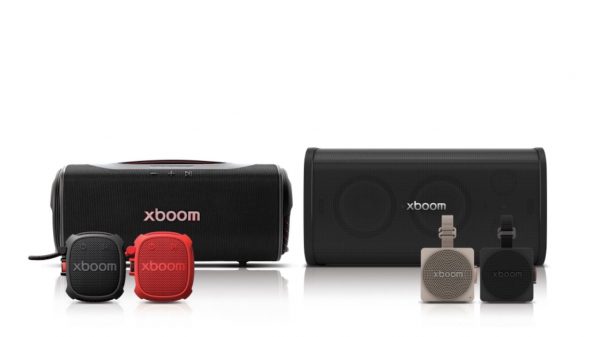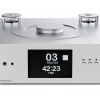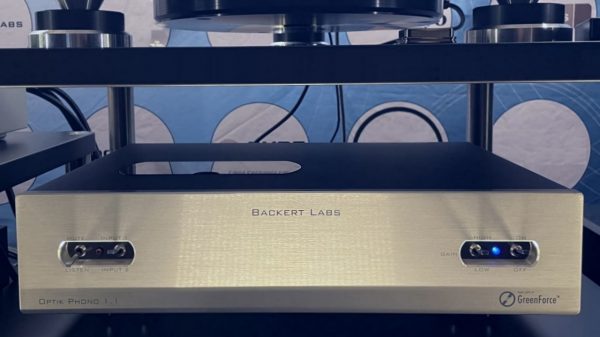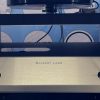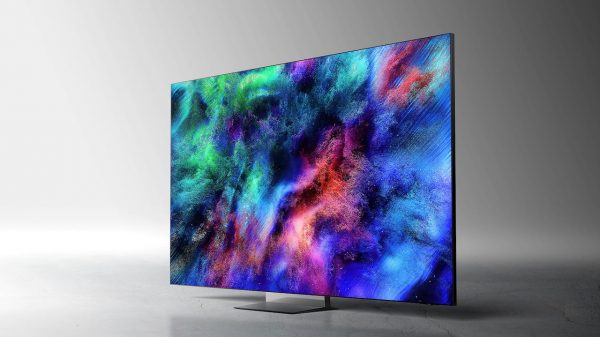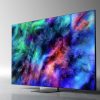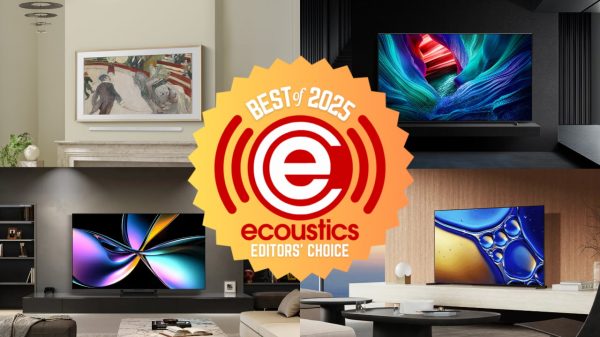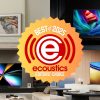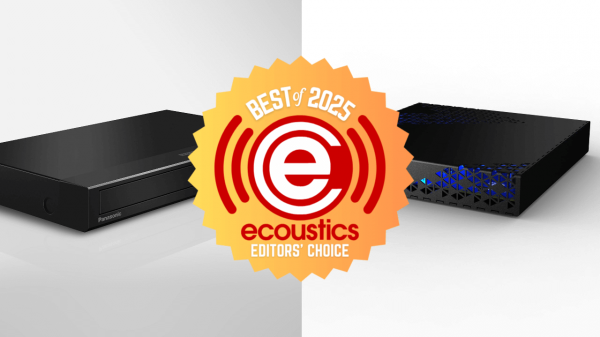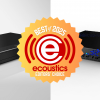Update: Watch our video podcast on YouTube, or listen to our podcast on Apple Podcasts or Spotify, discussing all CEDIA Expo 2024 – Best in Show Award Winners!
Table of contents
- What is CEDIA Expo?
- Best Overall Home Theater System (Cost No Object): Trinnov, Perlisten, Kaleidescape, Barco, Officina Acustica
- Best Budget Home Theater System: JBL MA Receiver and Stage 2 Loudspeakers with Samsung Premiere 9 UST Projector
- Best Stereo Sound (Cost No Object): Marantz Model 10 / Bowers & Wilkins 803 D4 tower loudspeakers
- Most Versatile Speaker: Theory Audio Design ic6 Speakers
- Best Home Theater Source Component: Kaleidescape Strato V
- Best Soundbar: Klipsch Flexus Core 300 with DIRAC Live Room Correction
- Best Subwoofer: SVS 17-inch Ultra R|Evolution
- Best Outdoor Landscape Speakers: Theory Audio Design Bollard Speaker
- Best Outdoor Soundbar: Ambisonic ASBR4, ASBR5, ASBR6 Soundbars
- Best TV: TCL 115-inch QM891G
- Best Art TV: Samsung The Frame
- Best Invisible Speakers: JBL Conceal In-Wall Speakers
- Best Projection Screen: Screen Innovations Black Diamond Fusion Screen
- Best Bright Room Projector: Epson Q Series Q7000
- Best Streamer: WiiM Ultra / Bluesound NODE Icon (Tie)
- Best Consumer Home Theater Projector: Sony BRAVIA 9
- Best Vending Machine: Moet & Chandon at Le Meridien Hotel
- The Bottom Line
What is CEDIA Expo?
Once a year, the top manufacturers of CI (custom installation) gear gather at CEDIA Expo to show off their wares to dealers, distributors, custom installers and integrators. Custom installers and integrators are the folks who build home theaters, whole home media systems and smart home automation systems for those who can afford such things. Of course, there are a vast range of budgets and requirements on these projects, but many of the systems showcased at CEDIA Expo run well into six figures and beyond.

At this year’s CEDIA Expo in Denver, eCoustics returned to the show to visit as many of the booths that featured audio and video products as we could so we could report on these products and technologies and identify our picks for “Best in Show.” While many of the products shown (and some of the ones we picked) are outside the budgets of most people, there were a few more affordable standout products that made our list. Also, inevitably the technologies developed for the highest performance products will trickle down into gear the rest of us can enjoy. After careful consideration, here are our picks for this year’s “Best in Show” for CEDIA Expo 2024.
Best Overall Home Theater System (Cost No Object): Trinnov, Perlisten, Kaleidescape, Barco, Officina Acustica

After an exciting debut in 2023, Trinnov’s WaveForming technology continued to stand out from the crowd at CEDIA Expo 2024. With a system comprised of Trinnov Altitude processors and amplification, 33 Perlisten speakers (including subwoofers) arranged in a 13.14.6-channel configuration, a Kaleidescape movie player, a room built by Officina Acustica in Italy, a dedicated video processor from MadVR Labs, a Barco Residential projector capable of cranking out 27,000 Lumens and a screen by Seymour Screen Excellence, Trinnov’s $1.2 million home theater system impressed show attendees (including us) with its outstanding sound and impeccable image quality.

Trinnov’s WaveForming tech is known for its ability to provide even, dynamic and extended bass response anywhere in the listening room, but the system’s resolution of detail throughout the audio spectrum was excellent with individual sound elements coalescing into a cohesive three dimensional dome of sound. The video quality was equally excellent with rich colors, exquisite detail and impressive contrast thanks to the Kaleidescape movie player, the MadVR Envy’s video processing, and the Barco projector’s high light output, stunning contrast and richly saturated colors. As they say, sometimes you get what you pay for.
Read More: WTF is Trinnov WaveForming?
Best Budget Home Theater System: JBL MA Receiver and Stage 2 Loudspeakers with Samsung Premiere 9 UST Projector
Closer to the other end of the price spectrum compared to the Trinnov system, JBL showed off one of their brand new MA Series receivers and Stage 2 loudspeakers on a simple 5.1.2-channel immersive home theater system. The system handled dynamic action movie clips and music tracks with confidence, creating a nice sense of spatiality and good dialog intelligibility. These speakers and receivers mark JBL’s return to the consumer retail market and are available directly from retail sites such as Amazon, Crutchfield and Best Buy. Most of JBL’s other audio products are available exclusively through Custom Installation channels.

JBL has gotten some attention (both positive and negative) for its marketing campaign for the MA receivers and Stage 2 speakers. Rather than targeting the traditional buyer of HiFi gear (middle-aged male gear freaks like me), the company tried something different. They portrayed the owners (and prospective buyers) of this type of gear as Gen Z millenial women, with all their caricaturized affectations. You can check out some of the videos here. Will this help the company be successful in reaching a new demographic? Time will tell.
Paired with the JBL audio system and speakers was Samsung’s brand new Premiere 9 UST projector which handled video duties with aplomb. They deployed a motorized screen that disappeared into the console when not in use. UST projectors like the Premiere 9 can provide performance that approaches that of a traditional high-end front projector or even a flat panel TV, typically with less complexity and lower cost. A system like this can be purchased at retail and set up pretty easily by a tech-savvy consumer for under $10,000.
Best Stereo Sound (Cost No Object): Marantz Model 10 / Bowers & Wilkins 803 D4 tower loudspeakers

Though Masimo, the parent company of both Marantz and Bowers & Wilkins, did have a small booth in the main exhibit hall, the good stuff was kept across the street from the convention center at Le Méridien Hotel. Here the company had filled an entire floor with gear and systems set up for training and demos. I got to hear Bowers & Wilkins iconic Nautilus speaker system ($100,000) driven by four stereo Classé Delta power amplifiers which sell for around $11,000 each. And that was a sonic treat to say the least. The systems were wired and powered with AudioQuest products.

The company also had a great-sounding multi-channel home theater demo comprised of speakers in the company’s 700 Signature series. These speakers combine elegant looks with excellent sound reproduction on both movies and music and would make a great choice for a home theater system that needs to be seen as well as heard.

The standout stereo system demonstration at the show featured Marantz’ new “10 series” components (streamer, disc player and integrated amp) driving the Bowers & Wilkins 803 D4 loudspeakers, and wired with Audioquest cables. Robert Silva and I both felt that this system brought a level of realism and impact to the music that was missing from most of the other systems we heard. System cost for the Model 10 integrated amp and one pair of speakers is approximately $40,000 ($25K for speakers, $15K for Model 10). If you need a source, the SACD 10 disc player and LINK 10N streaming preamp are expected to sell for $12,000 each.
Most Versatile Speaker: Theory Audio Design ic6 Speakers
Bucking the trend of using bombastic action movie clips for speaker demos (which can be fun, IMHO), Theory Audio Design’s CEO Paul Hales prefers to demonstrate his company’s speakers using real 2-channel stereo music tracks. He does this so the listener can appreciate how the ic6 reproduces music – real instruments and voices – without distracting visuals or artificially mixed multi-channel surround sound.

As he did last year, Mr. Hales began the demo with a pair of the ic6 in-wall/ceiling speakers ($695/each) mounted in the front walls, then demonstrated the same tracks through the same speaker in its hanging pendant enclosure. In both cases the music was punchy, dynamic and offered excellent imaging. When they added the Theory iws12-6 in-wall subwoofer ($2,100) into the mix, the performance went up an additional notch with deep, tight bass extension that gave the sound a rock solid foundation and would give any high-end “audiophile” speaker a run for its money.
What makes the speaker special is that this same ic6 speaker can be mounted in a ceiling, in a wall, on a wall or in a pendant, just by adding an affordable bracket or enclosure. The same speaker is also being used in the company’s new ballard landscape speaker enclosure (more on that later). This flexibility is particularly compelling if you’re putting together a stealth home theater or surround sound system. You could outfit your entire living room, media room or home theater with the ic6 – three in the front wall for left, center, right, two in the rear wall and four hanging from the ceiling in pendant enclosures for height effects. With identical drivers (and identical timbre) in all channels you’ll get a seamless and immersive dome of sound when watching movies, TV shows or listening to music, without any visible speakers.

The one catch? Theory Audio Design speakers are not sold as standard passive speaker for use with any old receiver or integrated amp. They only work with the company’s proprietary active loudspeaker controllers which are basically power amps with advanced DSP (Digital Signal Processing). Instead of plugging the ic6 directly into a receiver or power amp, you use a preamp/processor or an A/V receiver with preamp outputs to deliver sound to the ALC which then drives the speakers directly.

Pricing for a stereo pair starts at $1390 for the ic6 in-wall or in-ceiling speakers plus $2495 for a model DLC-250.4 4-channel active loudspeaker controller. And while $3885 plus the cost of a source device and/or receiver or preamp isn’t exactly cheap, it’s a fraction of the cost of many less capable speakers in the CI market.
Also, it’s worth noting that Theory’s active loudspeaker controllers are designed to drive a lot more speakers than one might expect. The 4-channel 250W DLC-250.4d can actually drive up to 64 of Theory’s ic6 speakers in “Hi Z” mode and the company’s DLC-1500.4d ($4,750) can power up to 300 Theory speakers in Hi Z mode. So the cost efficiency of the system increases exponentially in larger deployments.
Best Home Theater Source Component: Kaleidescape Strato V
Forget “Best in Show,” Kaleidescape’s new Strato V movie player ($3,995) may be my favorite new product of the year. Well-heeled movie lovers already know that Kaleidescape’s media player ecosystem is one of the best systems to watch movies and TV shows on at home (or on your yacht or RV). Kaleidescape combines the ultra high quality audio and video of physical media with the convenience of instant downloads. And it’s all wrapped up in one of the most intuitive, most elegant, dare I say “most fun” user interfaces.

What’s kept most people out of the Kaleidescape ecosystem in the past has been the price of entry. Previously you’d need to spend at least $12,000 on a player and movie server just to get started. Now, with the Strato V player, a one-time purchase of $3,995 allows you to store and watch up to 10 movies in high quality 4K resolution with HDR and lossless surround thanks to nearly a Terabyte of on board storage. And if you run out of space and want to download something new, no problem – the movie you delete from your player is still backed up in the Kaleidescape cloud, ready for you to re-load any time you get the urge. Movies cost about the same as they do on other movie download services or physical media. But the video and audio quality is better than any other online movie service with 4K resolution, Dolby Vision HDR and lossless immersive surround sound like Dolby Atmos and DTS:X.

If you do want to build up a collection of movies on your own local servers, the Strato V is compatible with all of Kaleidescapes secure, fast, industrial grade movie servers at sizes up to 131 Terabytes per server for traditional HDDs or 123 TB of solid state storage goodness.
Read More: Kaleidescape Drops Price of Admission to $3995 with Strato V Movie Player
Best Soundbar: Klipsch Flexus Core 300 with DIRAC Live Room Correction
Have you ever bought an audio system, brought it home, set it up just like it says in the manual and found that it didn’t sound nearly as good in your living room as it did in the store? That’s because one of the most critical components of a sound system is something you may not have a lot of control over – the room that the system is placed in. Walls, furniture, floor and ceiling may be too reflective or too absorbent (as far as sound goes). The layout of the room may prevent you from placing speakers in the ideal locations. Any number of elements in the room may interfere with getting the best sound.

DIRAC, a swedish technology company, has a fix for that. DIRAC’s room correction software goes well beyond the simple level adjustments you’ll find in most soundbars or basic AVRs. It can correct for sound anomolies via level adjustments, equalization and time domain correction. DIRAC Live is a tool used by professional custom installers to optimize home theater systems and it’s normally only found in expensive processors and receivers. But at CEDIA Expo, Klipsch showed off their brand new Flexus 300 Core Soundbar, the first bar to include DIRAC Live room correction.
Klipsch unveiled and demonstrated the Flexus Core 300 ($999) with optional Flexus Surr 200 wireless rear speakers ($399) and two of the optional Flexus Sub 200 12-inch wireless subwoofers ($499/each). With forward-firing, side-firing and upward-firing drivers on the bar and forward and upward-facing drivers on the wireless surround speakers, this created a 7.2.4-channel system. I have to say the sound was dynamic and spacious, with tight deep bass. It sounded better to me than more than a few discrete component-based systems I’ve heard.
Company reps say that the bar on its own can put out bass as low as 43 Hz, but with dual wireless subwoofers added, the system can extend all the way down to 23 Hz. You can go even lower as the bar includes a wired subwoofer output as well for a total of up to 3 powered subwoofers that can be connected at one time. The Flexus Core 300 soundbar features Dolby Atmos and DTS:X immersive sound decoding.
Read More: Klipsch Flexus Core 300 Soundbar is World’s First to Support DIRAC Live Room Correction
Best Subwoofer: SVS 17-inch Ultra R|Evolution

SVS likes to surprise people at shows. At CES, it was the new flagship speaker line, the Ultra Evolution series. At CEDIA, the surprise was the company’s brand new flagship subwoofers, the SB17 (sealed) and PB17 (ported) Ultra R|Evolution subwoofers. The sealed version is said to go all the way down to around 14 Hz while the much larger ported version can get down even further to about 10 Hz. Each unit has dual voice coils with a dedicated amp for each coil and a total power rating of 2800 watts. These specs were preliminary but these were certainly some impressive beasts.
Note: The company originally claimed an F3 point of 8 Hz for the ported version and 11 Hz for the sealed version but later e-mailed us a correction.
Read More: New SVS 17-inch Subwoofers Will Rock Your World
Video: New SVS 17-inch Sub Goes to 11 (Hz) – Here’s How
Best Outdoor Landscape Speakers: Theory Audio Design Bollard Speaker
We’ve mentioned Theory Audio before. In fact their ic6 in-wall/in-ceiling speakers got our pick for most versatile speaker at CEDIA Expo 2024. And further along those lines, the ic6 is getting brought to yet another use case: outdoor landscape speakers. Theory CEO Paul Hales surprised us during the demo playing music from a pair of mystery speakers which were rocking the room like nobody’s business. After the music faded, he pulled back a curtain to reveal that we were actually listening to the Theory ic6 *yet again* in its new bollard outdoor housing ($1,400 for housing alone or $2,095 for complete speaker-in-housing).

The company is also repurposing their iws12 subwoofer with an outdoor bollard housing for it ($1,900 for housing alone or $2,850 for complete unit with subwoofer). For those deploying these speakers directly on the ground (not on solid flooring) a burial thrust plate kit ($115) can be added. When I move out of the city into a sprawling mansion, I’ll be putting a few dozen of these on my estate grounds. The Theory bollard outdoor speakers are expected to begin shipping toward the end of this year.
Best Outdoor Soundbar: Ambisonic ASBR4, ASBR5, ASBR6 Soundbars
Speaking of outdoor speakers, music isn’t the only thing people are listening to outside these days. With more high quality outdoor TVs and projection screens on the market, many folks are bringing their TV and movie viewing outside to the pool or backyard. Why sit on the couch to watch a movie when you can lounge in a hot tub? And for these customers, Ambisonic has a solution: the Ambisonic Outdoor Soundbar. The ASBR4 is 4 inches high, ASBR5 is 5.25″ high and the ASBR6 is 6.5 inches high.
Featuring an outdoor-friendly weather-rated (IP65 pending) version of the company’s planar magnetic ribbon tweeter, the soundbar was rocking out at CEDIA Expo with some impressive SPLs, great extension and excellent dialog clarity. The company demonstrated the smallest bar (ASBR4) with and without the optional outdoor subwoofer and it actually delivered some pretty powerful bass on its own (though it was even more impressive with the sub).
The bar will be available in six stock color options – Studio Black/White, Satin Black/White, Gloss Black/White. Custom powder coats and custom automotive finishes will also be available. The company had one on display finished in genuine Lamborghini Orange, because you know: rich people.

The company plans to offer the outdoor soundbar in sizes optimized for any TV from 42-inch to 98-inch. It will be available in multiple speaker configurations: center channel only, left-right channel or left-center-right. The bar can be supplemented for surround sound with any of the company’s outdoor landscape speakers and outdoor subwoofers. The Ambisonic Outdoor Soundbar is expected to begin shipping in Q1, 2025. Pricing has not yet been announced.
Best TV: TCL 115-inch QM891G
If there’s one thing you can count on in the A/V industry, TVs continue to get bigger, brighter and cheaper every year. In 1995, one of the first flat screen plasma TVs sold for $15,000 and measured up at a whopping 42 inches. At CEDIA Expo, TCL showed off their new QM891G flagship 115-inch TV ($19,999 at Best Buy). It’s appreciably thinner than that plasma TV was but its screen is 6.5 times larger in surface area.

Big TVs aren’t uncommon these days. Sony, LG, Samsung and TCL all offer multiple 98-inch TVs and Hisense offers a 100-inch model. But what sets the TCL 115-inch QM8 TV appart is its extremely high brightness capability and support for every HDR format: Dolby Vision IQ, HDR10+, HDR and HLG (Hybrid Log Gamma). This and the set’s AI picture processing make it able to reproduce anything on that big screen from low quality YouTube screens and old DVDs to the latest UHD Blu-rays and 4K/HDR movies on your favorite streaming service.
We just wrapped up our review of the 65-inch version of the QM8 and found a lot to like about it. And while my own favorite TVs are still OLEDs, none of the OLED manufacturers make a TV this big (yet) and the smaller 97-inch OLED models sell for around the same price as the 115-inch TCL with around 30% less viewing area. Also, the TCL’s high brightness, thanks to miniLED backlighting and advanced local dimming, make it a better fit for bright living rooms and open spaces with lots of ambient light.
Buy TCL’s 115-inch TV now for $19,999 at Best Buy.
Best Art TV: Samsung The Frame
2024 seems to be the year of the “art TV.” The concept is simple: if you can make a big flat panel TV disappear when not in use by passing it off as artwork, it’s more likely to get installed in a living room where visual aesthetics are of paramount importance. When not in use watching TV or movies, these sets have a gallery or artwork mode which displays art on the screen and the screen itself is adorned with an elegant frame. LG and Sony have partnered with a company called “Leon” who makes custom frames for their OLED and LED/LCD TVs. Earlier this year both Hisense and TCL introduced their own art TVs in an attempt to get into this niche, but very lucrative market.

But Samsung was here first, and frankly, they’re doing it better than anyone. I spent quite a bit of time admiring the latest The Frame by Samsung and was actually considering touching it to see if the brush strokes in the displayed art were real. But then it switched to a different piece of art. Something about the screen’s matte finish and the uniform but not excessively bright image just made it look more like an actual painting and less like a TV.

This year, Samsung has introduced matching Music Frame speakers which can be hung on either side of the TV to produce rich sound when watching TV shows or movies or listening to music. The Music Frame speaker ($399 at Amazon) is an actual art frame which hides the speaker drivers inside and uses a small gap outside the artwork area to radiate sound out to the listener. Don’t forget that Samsung acquired legendary sound and speaker company Harman several years ago, so they’ve got access to some of the brightest minds in audio when designing innovative audio products like this.
Samsung’s The Frame TVs (2024 models) are available now in sizes from 43 to 85-inches, priced from $999 to $4,299.
Best Invisible Speakers: JBL Conceal In-Wall Speakers
While the Samsung Music Frame speakers blend in with the room by camouflaging themselves as artwork, JBL’s Conceal speakers are actually invisible. They use panels of “FidelityGlass” designed by Stealth Acoustics to radiate sound using a pair of actuators with a traditional bass driver behind the panel. This assembly gets mounted to the studs in your wall and then “mudded” into the wall to create a completely smooth surface. The wall can then be painted with standard paint making the speaker disappear. There is no grille or other sign that there is a speaker there because the wall effectively is the speaker. It’s only by holding your hand on top of the area that you can feel the vibrations of sound coming from within.

If you’re worried about cracking your walls, don’t be. Harman/JBL rep Jim Garrett told us at the show that these types of in-wall actuator/panel speakers have been in use for over 10 years with no signs of cracking. Just don’t drive a nail in the speaker to try to hang a painting on top of it because that won’t end well.
Best Projection Screen: Screen Innovations Black Diamond Fusion Screen
Something that ISF co-founder Joel Silver told me once that always stuck with me was that projectors would be so much better if they could only project black. I know, that sounds weird, but when you think about it, it’s true. A projection screen is typically white, or maybe grey, so even when nothing is shining on it, it’s never black. Areas of that white or grey screen only look black by comparison to the brighter areas of the image. Meanwhile an OLED or even an LED/LCD TV can produce true black by just not illuminating those areas of the screeen. But you can’t make a projector screen out of black material, can you? It turns out, you can.
Screen maker Screen Innovations was showing off not one but two different types of black projection screen. One of them – the Zero-G Pro, with Carbon Black material – is intended primarily for commercial use and requires a really bright and powerful projector to compensate for its low (0.2 to 0.4) gain. Adele liked it so much more than LED video walls that she mandated that Carbon Black screens be used as the backdrop for her Las Vegas shows. It not only provides a more pleasing background image for her performances but it saves thousands of dollars in electricity (and the associated greenhouse gas emissions) as well, with each performance. Pricing varies, but in larger sizes, the Zero G screen sells for around $85/square foot.

Meanwhile, the company’s new Black Diamond Fusion screen actually offers unity gain (1.0) which means it can be used in a typical home theater or even a living room if you have a moderately bright projector. We saw both projectors in action at CEDIA Expo 2024 and it was incredible just how much of the room’s ambient light they absorbed while dutifully reflecting back the projected image. The only drawback of the Black Diamond Fusion screen is that its design is specifically made to focus the projected light toward the viewing area, which means it doesn’t looked as impressive when you move well off to the side (maybe 60 degrees off center). This is necessary in order to reach that 1.0 gain value with a black screen. But in a home theater implementation where most of the seating is centered on the screen, this really shouldn’t be a problem.
The new Black Diamond Fusion screen improves over previous screens by eliminating hot-spotting, maintaing even illumination levels across the entire screen surface within a wider viewing angle. Screen Innovations CEO Kim-Anthony Parker told us that they recommend a projector with at least 3,000 Lumens of output, but in a controlled lighting environment you can get by with less and still get excellent results. The cost of the Black Diamond Fusion varies depending on the size but for larger screen sizes, it’s around $55/square foot. The company’s existing Black Diamond screen is available in 0.8, 1.2 and 1.4 gain versions. The new Black Diamond Fusion will begin shipping to dealers soon and is available to order in custom screen sizes and aspect ratios.
Best Bright Room Projector: Epson Q Series Q7000
Epson, the champion of LCD projection, is actually the top-selling manufacturer of projectors worldwide. But within the home theater projection space, Epson has developed the reputation as the “high value alternative” to more expensive brands. This year, the company is making a push into the higher end of the market with their new Q Series.

The Q Series projectors are building upon Epson’s reputation of delivering exceptional brightness and taking that concept to the next level. The flagship Q7000 delivers a whopping 10,000 Lumens of peak brightness, and it does so in a fairly compact chassis while maintaining a whisper quiet background noise of only 33 dB (even lower in eco mode).
So who would need (or event want) a veritable light cannon with 10,000 lumens? Rich people. Rich people with sprawling interiors who want a huge, gorgeous 4K display for TV and movie viewing which can be used in bright rooms and which virtually disappears when not in use. Pair it with a motorized screen from Stewart or Screen Innovations or Seymour Screen Excellence and the screen will only make its presence known when you want it to. And because it can get so bright, it’s OK to leave the shades open or the lights on.

Epson was one of the few exhibitors that showed off their projectors – in this case, the flagship QL7000 ($29,999) – in a bright living room environment. And when that 180-inch motorized screen dropped down and the football game came on, I might as well have been standing on the 50 yard line, except without the risk of a concussion or other bodily harm. The company also showcased their QB1000 ($7,999) and QL3000 ($14,999) in a darkened home theater environment to show they’re equally happy playing with the lights turned low.

All Q Series projectors offer HDR10+, HDR10 and HLG high dynamic range support with 4K resolution thanks to dual phase pixel shift. They all feature a laser+phosphor lighting system for extended life – around 20,000 hours until half brightness. By using three LCD imaging chips (one for each primary color), the Q Series projectors don’t need a color wheel which means you won’t see those RBE (rainbow effect) nasties that can plague some DLP-based projectors.
Read More: Epson Q-Series Projectors Will Light Up the Brightest Living Spaces
Best Streamer: WiiM Ultra / Bluesound NODE Icon (Tie)
Network streamers, little boxes that allow you to access music from your own digital library or music streaming service, used to be a niche product, strictly for tech-savvy audiophiles. But the streamer market has exploded in the last few years as traditional audio brands have entered the mix and new companies have arisen in response to high consumer demand. Apparently listening to streaming music on one’s phone through a cheap pair of headphones isn’t actually good enough for millions of people.

Two companies had streamers that stood out to us at this year’s show, one established leader in the space (Bluesound) and the other an uppity new comer (WiiM). Both should satify the needs of audiophiles who want convenient access to music from anywhere in the home, but they reach that goal in slightly different ways and at very different price points: $999 for the NODE Icon vs. $329 for the WiiM Ultra.
The Bluesound NODE Icon is the first NODE with a screen, which is nice when you want to interact with your music without having to look at your phone. It also features not one but two of the high-end ESS Sabre 9039 DACs for high resolution audio support up to 24bits/192Khz. It also can serve as an outboard DAC for other digital sources thanks to fiberoptic and coax inputs as well as an eARC HDMI port for connection to a TV or projector.

As an audiophile-friendly source, the NODE Icon even offers balanced (XLR) audio outputs – something that we rarely see on consumer products at this price point. The NODE Icon even includes two independent THX certified AAA headphone outputs so you can enjoy your music collection (or TV viewing) in private. What differentiates the NODE Icon from other brands is that it, of course, operates on the BluOS platform and ecosystem, which has been enhanced and expanded since 2013. Those who are already happily using the BluOS Controller App will not need any re-training.
Meanwhile WiiM is quite a bit newer at this, having burst onto the streaming scene in late 2021 with its first streamer, the WiiM Mini. However, WiiM is actually a product of the company LinkPlay who has been developing both the hardware and software for other brands’ streaming products since 2014. So they’re not exactly noobs at the whole streaming music thing.
Like the NODE Icon, the WiiM Ultra features a small color screen, but the WiiM goes one better as the screen itself offers touch controls where the NODE Icon’s control buttons are separate from the screen. On the plus side, the Icon’s screen is slightly larger than the one on the WiiM Ultra. The WiiM Ultra feature set is quite similar to the Bluesound NODE Icon with digital and analog inputs and outputs and even an eARC HDMI port for connecting a TV (but no balanced analog outputs). There is one major exception: the WiiM Ultra does not (yet) support Apple AirPlay 2. WiiM reps told me that this is simply a licensing issue and it is only a matter of time before AirPlay support is added. WiiM does support AirPlay 2 in all of its other streaming products so those who favor Apple Music and the iOS ecosystem will likely see AirPlay 2 support on the WiiM Ultra soon.
Also, while both streamers promise room correction, the one built into the WiiM products (including the WiiM Ultra) is a home-grown offering which is still a bit of an unknown quantity. Many owners and some reviewers have reported good results with it, but it is currently only available on iOS devices (not Android). Also, it appears to only adjust EQ (equalization) to compensate for room anomalies. Meanwhile the NODE Icon is “DIRAC Live-ready.” DIRAC Live is an advanced room correction system which adjusts not only EQ but also phase (time domain adjustment) which should lead to more effective room correction. It is not clear whether the DIRAC upgrade for the NODE Icon will incur an additional fee.
If you’re already a Bluesound customer, or need/want the extra power of DIRAC Live room correction and like the option of balanced XLR outputs, the NODE Icon would make an excellent addition to your system. If you’re just getting started in audiophile music streaming or want to upgrade from a more basic streamer, the WiiM Ultra makes an extremely compelling value statement.
Best Consumer Home Theater Projector: Sony BRAVIA 9
One surprise that lay in store for CEDIA Expo attendees (including yours truly) was Sony’s announcement of two new home theater projectors, the BRAVIA 8 and BRAVIA 9. These are Sony’s first projectors to bear the BRAVIA badge as the company is tying together TVs, home theater speakers and projectors into a single brand name. And while there were plenty of excellent home theater projectors on display at CEDIA Expo 2024 – some priced at over $200,000 – the BRAVIA 9 stood out as a strong performer for most installations at a much lower price point ($32,999).

The BRAVIA 9 offers 3400 lumens of brightness, native 4K resolution with 3 SXRD LCOS imaging chips and a laser+phosphor light engine rated to last at least 20,000 hours until half brightness. It includes two HDMI 2.1 ports with support for 4K/120 sources and ALLM (auto low latency mode) support for next gen gaming consoles and gaming PCs. Early measurements show a screen lag time as low as 12 milliseconds (gamers are gonna love this projector). Advanced frame by frame HDR tone mapping allows the projector to optimize 4K/HDR content to best suit the capabilities of the projector without clipping.
In the demo room, the BRAVIA 9 (XW8100ES) projector lit up a 150-inch Studiotek 130 screen from Stewart Filmscreen. The projector was paired with a full suite of 1000 Series Utopia speakers from Focal powered by Naim amplifiers, with Sony’s own STR-AZ7000ES receiver providing the switching and audio decoding. Sony compared the BRAVIA 9 to last year’s flagship, the XW7000 and while that was an excellent projector, the dynamic tone mapping improvements on the BRAVIA 9 allowed both specular highlights and shadow detail to be much better represented on the BRAVIA 9. The BRAVIA 9 excelled in all manner of content with a punchy and vibrant image with excellent contrast and detail.

The sound of this demo system was no slouch either. The 9.2.4-channel Focal system rang up for about $88,000 for the fifteen speakers (including subwoofers), $3,300 for the Sony AZ7000ES receiver and $6,000 for the two NAIM CI NAP-108 power amplifiers. Dynamics were excellent, details were crisp and precise and the overall soundstage was expansive and enveloping. Bass response was tight and powerful from the two subs. The bass wasn’t as extended or precise as in the Trinnov system. But then again, we’re talking about a $150K system with two subwoofers vs. a $1.2 million system with fourteen subwoofers, so you can’t expect miracles. I will say the Sony/Focal home theater was probably about as good as it gets for us mere mortals. I’d love to see (hear) what the Focal speakers could do with Trinnov’s WaveForming processing.
Best Vending Machine: Moet & Chandon at Le Meridien Hotel

OK, this one is sort of silly, but have you ever seen a Champagne vending machine before? Because I hadn’t. And I’ve been around the block a couple of times. In the lobby of Le Meridien hotel (where Masimo held their CEDIA Expo demos), we spotted this little treat: not just Champagne but Moet & Chandon champagne. The machine only takes tokens as payment and a token apparently sells for $34 plus tax. I was tempted to test it out, but I’m pretty sure Brian would have rejected this one from my expense report.
The Bottom Line
Last year’s CEDIA Expo was busy and upbeat. This year’s show also had an overall positive and enthusiastic vibe with long lines for demos, plenty of animated discussions about the CI business, and a host of exciting new audio/video technologies and products that will certainly be lighting up the lives of CI customers around the world. Congratulations to all of our eCoustics “Best in Show” winners and we’ll see you next year in Denver.
Related Reading:
- CEDIA Expo 2024 Audio and Video Highlights: Part 1 (Epson, Klipsch, LG, Trinnov, Samsung, and Sony)
- CEDIA Expo 2024 Audio and Video Highlights: Part 2 (Ambisonic, Arcam, DALI, JBL Synthesis and Yamaha)
- CEDIA Expo 2024 Audio and Video Highlights: Part 3 (Ascendo, Theory Audio, Bowers & Wilkins, L-Acoustics, TCL, JVC and Grimani Systems)
- All Stories from CEDIA Expo 2024



